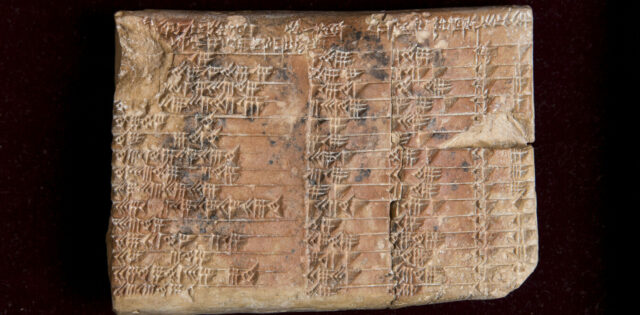The ancient Babylonian tablet, known as Plimpton 322 was discovered by Edgar K. Banks, who later became the inspiration for the Indiana Jones movie series. The tablet discovered in Iraq almost 100 years ago, is made of clay and thought to be 3,700-year-old. Banks sold it to George Plimpton for $10 but now the significance of the tablet and its importance to mathematics is started to become more clear.
Two professors from the University of New South Wales, have worked on cracking the code and learned that trigonometry was discovered not by Greeks, but by ancient Babylonians and the numbers of the Plimpton 322 are part of a trigonometric table. It is believed to be the foundation of trigonometry that uses ratios and not angles or circles. It is the work of pure genius and sheds a light on other ancient Babylonian tablets discovered by archaeologists.
By learning about the thought processes and science used by ancient societies, researchers can learn more about their lives and how society functioned in those times. Such tablets were probably used on construction sites and surveying of fields, which means they can even help elude the mysteries of the pyramids.
Dr Daniel Mansfield with the Plimpton 322 Babylonian clay tablet in the Rare Book and Manuscript Library at Columbia University in New York. Image: UNSW/Andrew Kelly
UNSW Sydney scientists have discovered the purpose of a famous 3700-year-old Babylonian clay tablet, revealing it is the world’s oldest and most accurate trigonometric table, possibly used by ancient mathematical scribes to calculate how to construct palaces and temples and build canals.
The new research shows the Babylonians, not the Greeks, were the first to study trigonometry – the study of triangles – and reveals an ancient mathematical sophistication that had been hidden until now.
“Plimpton 322 has puzzled mathematicians for more than 70 years, since it was realised it contains a special pattern of numbers called Pythagorean triples,” says Dr Daniel Mansfield of the School of Mathematics and Statistics in the UNSW Faculty of Science.
“The huge mystery, until now, was its purpose – why the ancient scribes carried out the complex task of generating and sorting the numbers on the tablet.
“Our research reveals that Plimpton 322 describes the shapes of right-angle triangles using a novel kind of trigonometry based on ratios, not angles and circles. It is a fascinating mathematical work that demonstrates undoubted genius.
“The tablet not only contains the world’s oldest trigonometric table; it is also the only completely accurate trigonometric table, because of the very different Babylonian approach to arithmetic and geometry.”
The new study by Dr Mansfield and UNSW Associate Professor Norman Wildberger is published in Historia Mathematica, the official journal of the International Commission on the History of Mathematics.





















Fantastic
I found this article fascinating. This unraveling of the 100+ year old
discovery sheds new light on just what ‘other’ ancient people knew. This reminds me of the Dick Teresi book, Lost Discoveries. Sometimes scholars become amazed to find evidence for things they couldn’t accept were known by non-Greek people. In today’s world there are other generalizations of a biasness like this same concept of an all-things-great came only from an all wise ancient Greek-centric hegemony. We today have long, been acoustomed to persist the European-centric achievement. That biasly applied Ocam’s Razor has discredited and hid many discoveries of Americas as fake, and rarely revisited when new evidences support such revision. Could we be opening a new chapter where our cited biased sources get replaced with the original contributors? Do we need to rethink all of our preconceived notions of the ancient Americas, the ancient Africans, the ancient Near Eastern, the ancient Orient, or even the ancient Indo-Asian? They couldn’t possibly have done anything like the Greeks? Or could they? This story should be less about Babylonians using Pythagorean theorems and more about Babylonianian Trigonometry that Greeks later discovered. Babylonians didn’t time travel to steal the Greek’s contributions. Must we still pay Hellenistic homage to keep the hegemony fed? Greeks accomplished great things but they were not the only civilization that could use their minds. Sarcastically I say the savages of the new world and the many others in non-Hellenistic reaches have been abusively silenced to prevent bruising the ancient Greek world ego. Please let’s start off correctly using Ocam’s Razor instead of purposefully avoiding evidence as if it protects someone’s ego. We should be ‘revisiting’ the ancient’s contributions because we really don’t know them the way we think we do. We do ourselves a great disservice to narrow our views of what any civilization could have
known. Thank you for this article. More, please.